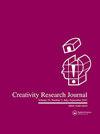语义距离和替代使用任务:独创性可靠自动评估的建议
IF 2.5
3区 心理学
Q2 PSYCHOLOGY, EDUCATIONAL
引用次数: 14
摘要
摘要语义距离越来越多地用于对发散思维任务的独创性进行自动评分,如交替使用任务(AUT)。尽管对语义距离有一些心理测量支持,包括与人类创造力评级的正相关,但还需要做更多的工作来优化其可靠性和有效性,包括为AUT管理确定最大可靠的项目(对象)。我们根据系统的物品选择策略(皮带、砖块、扫帚、水桶、蜡烛、时钟、梳子、刀、灯、铅笔、枕头、钱包、袜子)确定了一组13件AUT物品。该项目集得出了可接受的可靠性估计,并被发现与人类创造力评级和创造性人格因素适度相关(研究1)。这些结果在新的参与者样本中得到了复制(研究2)。最后,我们提出了以下使用语义距离对AUT独创性进行可靠有效评估的建议:1)基于理论/实践考虑做出选择,2)管理(部分或全部)本研究的13个项目;3) 如果必须使用其他项目,则避免使用复合词作为AUT项目(例如,吉他弦);4) 在时间允许的情况下包括尽可能多的AUT项目;5) 指导参与者“要有创造性”;以及6)解决将想法数量和质量混为一谈的流利性混淆(例如通过最大得分)。本文章由计算机程序翻译,如有差异,请以英文原文为准。
Semantic Distance and the Alternate Uses Task: Recommendations for Reliable Automated Assessment of Originality
ABSTRACT Semantic distance is increasingly used for automated scoring of originality on divergent thinking tasks, such as the Alternate Uses Task (AUT). Despite some psychometric support for semantic distance – including positive correlations with human creativity ratings – additional work is needed to optimize its reliability and validity, including identifying maximally reliable items (objects) for AUT administration. We identify a set of 13 AUT items based on a systematic item-selection strategy (belt, brick, broom, bucket, candle, clock, comb, knife, lamp, pencil, pillow, purse, sock). This item-set resulted in acceptable reliability estimates and was found to be moderately related to both human creativity ratings and a creative personality factor (Study 1). These results replicated in a new sample of Participants (Study 2). We conclude with the following recommendations for reliable and valid assessment of AUT originality using semantic distance: 1) make choices based on theoretical/practical considerations, 2) administer (some or all of) the 13 items from this study; 3) if other items must be used, avoid compound words as AUT items (e.g., guitar string); 4) include as many AUT items as time permits; 5) instruct participants to “be creative”; and 6) address fluency confounds that conflate idea quantity and quality (e.g., via max scoring).
求助全文
通过发布文献求助,成功后即可免费获取论文全文。
去求助
来源期刊

Creativity Research Journal
Multiple-
CiteScore
5.10
自引率
7.70%
发文量
52
期刊介绍:
Creativity Research Journal publishes high-quality, scholarly research capturing the full range of approaches to the study of creativity--behavioral, clinical, cognitive, crosscultural, developmental, educational, genetic, organizational, psychoanalytic, psychometrics, and social. Interdisciplinary research is also published, as is research within specific domains (e.g., art, science) and research on critical issues (e.g., aesthetics, genius, imagery, imagination, incubation, insight, intuition, metaphor, play, problem finding and solving). Integrative literature reviews and theoretical pieces that appreciate empirical work are extremely welcome, but purely speculative articles are not published. Readers are encouraged to send commentaries, comments, and evaluative book reviews.
 求助内容:
求助内容: 应助结果提醒方式:
应助结果提醒方式:


